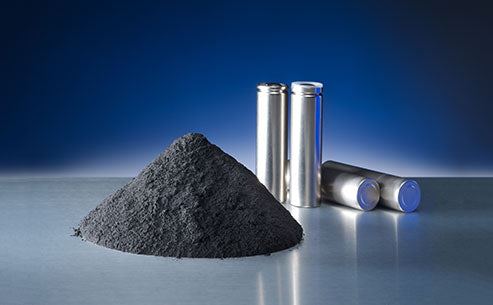
The characteristics of the anode material
As a lithium-ion battery anode material, it should meet the following requirements.
① The oxidation-reduction potential when inserting lithium should be as low as possible, close to the potential of metal lithium, so that the output voltage of the battery is high;
②Lithium can be reversibly deintercalated in the host material as much as possible, with a large specific capacity value;
③In the process of lithium desorption, the main structure has no or little change to ensure good cycle performance;
④ The change of the oxidation-reduction potential with the number of lithium inserted should be as small as possible, so that the voltage of the battery will not change significantly, and a relatively stable charge and discharge can be maintained;
⑤The insertion compound should have good electronic conductivity and ionic conductivity, which can reduce polarization and can charge and discharge large batteries;
⑥ It has a good surface structure and can form a good solid electrolyte interface (SEI, solid electrolyte interface) film with the liquid electrolyte;
⑦Lithium ion has a large diffusion coefficient in the main material, which is convenient for rapid charging and discharging;
⑧ Cheap price, abundant resources, no pollution to the environment, etc.
Classification of anode materials

(1) According to their composition There are many classification methods for anode materials. According to their composition, they can be divided into two categories: carbon anode materials and non-carbon anode materials. Carbon materials mainly include graphite and graphitized carbon materials, and non-graphite (amorphous) carbon materials. Graphite carbon materials include natural graphite, artificial graphite and modified graphite. They have a good layered structure, LixC6 interlayer compound is formed between the layers of lithium ions inserted into graphite, the theoretical capacity is 372mA·h/g, there is a good voltage platform, and there is no charge (lithium deintercalation) voltage hysteresis; amorphous carbon materials can be divided into easily graphitized carbon materials (also called soft carbon) and difficult to graphitize carbon materials (also called hard carbon) according to their degree of graphitization difficulty. Non-graphitized carbon materials and graphite have different lithium storage mechanisms, and they usually show higher specific capacity, but the voltage platform is higher, there is potential hysteresis, and the cycle performance is not ideal. The reversible lithium storage capacity generally decays faster as the cycle progresses.
Non-carbon anode materials include tin-based materials, silicon-based materials, nitrides, titanium-based materials, transition metal oxides, and other new alloy materials. The development of non-carbon anode materials is mainly based on the low specific capacity of carbon-based materials, which cannot meet the increasing battery capacity requirements. In addition, carbon-based materials have low first charge and discharge efficiency and have shortcomings such as organic solvent co-embedding. Therefore, while developing carbon materials, people have also carried out research and development of high-capacity non-carbon anode materials.
Tin-based materials include tin oxides, tin-based composite oxides, tin salts, stannates, tin alloys, etc.;
Silicon-based materials are divided into silicon, silicon oxides, silicon/carbon composite materials, silicon alloys, etc.;
Titanium-based anode materials mainly refer to titanium oxides, including TiO2, spinel structure Li+i2O4, Li4/3 Ti5/3O4, etc.;
Nitride mainly refers to various transition metal nitrides, which are lithium-containing anode materials like Li4/3 Ti5/3O4;
Alloy materials include Sn-based, Sb-based, Si-based, Al-based alloy materials and so on.
Anode materials include two types of carbon materials and non-carbon materials, which are classified as follows:
Carbon materials: graphite-like carbon materials (including natural graphite, artificial graphite, and modified graphite) and amorphous carbon materials (including easy graphitization carbon materials and difficult graphitization carbon materials);
Non-carbon materials: tin-based materials, silicon-based materials, amides, titanium-based materials, transition metal oxides, alloy materials.
(2) According to the structure of the anode materials, it can be divided into two categories: crystalline materials and amorphous (amorphous) materials. Stone and ink carbon materials have high crystallinity and belong to crystalline materials; while amorphous carbon materials have low crystallinity, we regard them as amorphous materials. Most tin oxides in tin-based materials are crystalline compounds. Because it has a huge volume effect during the charging and discharging process, which affects the structural stability and cycle performance of the material, the modification of tin oxide leads to the appearance of amorphous tin-based composite oxide. Non-metallic silicon in silicon-based materials also has two types, crystalline and amorphous. Among them, amorphous silicon has better electrochemical performance, and the modification of silicon is basically aimed at amorphous silicon. Alloy materials can also be divided into two types: crystalline and amorphous according to their structure.
(3) Negative electrode materials are divided into two categories: powdered materials and thin-film materials. So far, most of the negative electrode materials studied are powdered materials, and there are few studies on film morphology, mainly focusing on metal (alloy) films, tin oxide films, silicon-based films, etc. Compared with powder electrodes, thin-film electrodes do not need to add adhesives and conductive agents. This allows the film electrode to more intuitively reflect the performance of the electrode material, and at the same time has the advantages of simple design, low internal resistance, and good charge and discharge performance, which makes the film electrode material very promising.
















